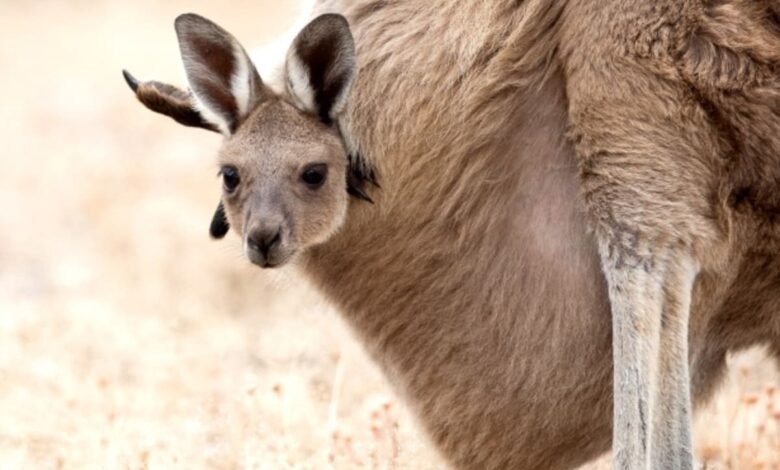The Remarkable Kangaroo Pouch: A Marvel of Nature

The kangaroo pouch is one of nature’s most fascinating features. Found in female kangaroos, it serves as a safe and nurturing space for their young, known as joeys, to grow and develop. This unique pouch has captured the imagination of scientists, animal lovers, and curious minds alike. In this article, we will delve into the kangaroo pouch’s biological significance, how it functions, the role it plays in the survival of kangaroos, and its evolutionary importance.
What Is a Kangaroo Pouch?
A kangaroo’s pouch is a specialized skin fold located on the abdomen of female kangaroos. It is a crucial part of their reproductive system, offering a safe, warm, and protective environment for the young joeys after birth. The pouch is not just a simple bag—it has evolved over millions of years to fulfill the specific needs of kangaroo species.
The pouch is lined with soft, muscular tissue, and its structure can vary slightly between different species of kangaroos and other marsupials. The kangaroo pouch primary function of the pouch is to protect the underdeveloped joey after it is born. Since kangaroos, like other marsupials, give birth to relatively undeveloped offspring, the pouch provides a secure, sheltered space for the baby to continue its development outside the womb.

The Biological Design of the Pouch
The kangaroo pouch is an intricately designed structure that serves multiple functions. It isn’t just a “pocket” for the joey to hang out in; it’s a dynamic, adaptable system that changes as the joey grows. Here, we’ll break down the features of the pouch and why they are so crucial for the kangaroo’s reproductive success.
Muscular and Flexible Walls
The pouch’s walls are lined with a layer of smooth muscle tissue, which allows the pouch to adjust its size according to the growing joey. This flexibility is essential for accommodating Joey’s rapid growth after birth. The muscles also kangaroo pouch help the mother kangaroo maintain control over the pouch’s opening, ensuring that the joey remains safe inside even during movements like hopping or grazing.
Moisture Regulation
Temperature and humidity regulation inside the pouch are vital for the joey’s health. The pouch provides a warm, controlled kangaroo pouch environment, much like a womb, ensuring that the baby kangaroo receives the right conditions to grow. The skin inside the pouch also helps with moisture retention, preventing the joey from becoming dehydrated while nestled inside its mother’s protective fold.
Pouch Opening and Closure Mechanism
The opening of the pouch is guarded by strong, flexible muscles, which help the mother kangaroo control access. The pouch opens at the front of the abdomen and can be closed tightly when needed. This closing mechanism is especially important when the mother needs to move quickly or avoid predators, ensuring the joey stays securely inside.
The Function of the Pouch in Kangaroo Reproduction

One of the most compelling aspects of the kangaroo pouch is its role in reproduction. The pouch is not merely a post-birth feature; it plays an essential part in the kangaroo’s reproductive strategy. Female kangaroos give birth to underdeveloped young that are just a few centimeters long and weigh almost nothing. The pouch offers the ideal conditions for these premature joeys to grow, develop, and mature until they are ready to survive on their own.
Early Development of the Joey
After a kangaroo gives birth, the newborn joey is tiny—about the size of a peanut—and blind. It crawls into the pouch immediately, where it attaches to one of the mother’s teats. This initial stage of development inside the pouch lasts for several months, and during this time, the joey grows exponentially. The warmth and safety of the pouch allow the joey to develop its vital organs, muscles, and fur.
Transition to Partial Independence
As the joey matures, it begins to venture outside the pouch, although it continues to return for comfort, warmth, and feeding. This transition period lasts for months, and Joey slowly learns to forage for food while still relying on the pouch for safety and nutrition. During this time, the pouch acts as both a sanctuary and a stepping stone to greater independence.
Weaning and Gradual Pouch Departure
Eventually, the joey is weaned off its mother’s milk and starts to eat solid food. At this point, the joey no longer needs to stay in the pouch full-time but may continue to use it for shelter and security as it learns to survive on its own. This gradual weaning process ensures that the joey has the time it needs to build up strength and survival skills before becoming fully independent.
How Long Does Joey Stay in the Pouch?
The length of time a joey spends in the pouch varies depending on the species of kangaroo, environmental factors, and the individual animal’s development. On average, joeys will stay in the pouch for around 4 to 6 months. During this time, they undergo significant physical changes, transitioning from tiny, underdeveloped creatures to more mature and capable young kangaroos.
However, the time spent in the pouch is not always uniform. Some species of kangaroos, like the red kangaroo, may have joeys that stay in the pouch for a longer period, while others might develop more quickly. The mother’s milk and the amount of care she provides also play a significant role in determining the development rate of the joey.
The Evolutionary Importance of the Kangaroo Pouch
The evolution of the kangaroo pouch is a remarkable example of how animals adapt to their environments. The pouch allows kangaroos to give birth to small, underdeveloped young, which in turn enables them to avoid the physical limitations of having larger, fully developed offspring. This adaptation has allowed kangaroos to thrive in a wide variety of ecosystems, from the arid deserts of Australia to its lush grasslands.
Survival Advantage
The pouch’s ability to keep the joey safe and warm provides a survival advantage for the kangaroo. Since kangaroos live in often harsh environments with extreme temperatures and predators, the pouch gives the young a better chance of surviving the early stages of life. It allows the mother to keep moving, foraging, and escaping threats, all while carrying her young with her.
Reduced Dependency on the Environment
Because the pouch is an internal, self-contained environment, the mother kangaroo doesn’t need to worry as much about external environmental conditions, such as predators or adverse weather, directly affecting the survival of her young. The pouch serves as a buffer between the outside world and the delicate developmental process taking place inside the joey.
Adaptations to Different Species
Different species of kangaroos and marsupials have evolved slightly different pouch structures, adapted to their particular environments. For instance, tree-dwelling kangaroos, like the tree kangaroo, have evolved pouches that face backward to prevent their babies from falling out when climbing. Similarly, some species have evolved tighter, more secure pouches to protect against predation.
Understanding the Role of the Pouch in Kangaroo Behavior
The kangaroo pouch plays a significant role not only in reproduction but also in the overall behavior and social dynamics of kangaroo populations. Female kangaroos, in particular, exhibit fascinating maternal behaviors related to pouch management, bonding, and care.
Mother-Young Bonding
The bond between the mother kangaroo and her joey is incredibly strong. As the joey grows, the mother will engage in various behaviors to ensure its safety and well-being, including licking and grooming the young. The joey will often seek comfort by crawling back into the pouch when it feels insecure or tired. This nurturing relationship ensures that the joey receives the protection it needs to grow and thrive.
Pouch as a Safe Haven
During periods of stress or danger, such as when a predator is nearby, the mother kangaroo will instinctively shield her young. The joey will often burrow deeper into the pouch, seeking safety. This close relationship between the mother and joey is crucial for the joey’s survival, and it also strengthens the overall social dynamics of kangaroo populations.
Mother’s Ability to Manage Multiple Offspring
Interestingly, female kangaroos have the ability to manage more than one joey at different stages of development simultaneously. They can have a joey in the pouch, another in a stage of development outside the pouch, and even a third embryo developing in the uterus, all at once. This fascinating ability is an evolutionary advantage that allows kangaroos to maximize their reproductive success and ensure their species’ survival.
The Kangaroo Pouch in Pop Culture and Wildlife Conservation
The kangaroo pouch has become an iconic symbol of Australian wildlife. It is featured prominently in both scientific discussions and popular media, from documentaries to animated movies like Kangaroo Jack and Zootopia. This widespread fascination has led to increased awareness of kangaroo conservation efforts.
Conservation of Kangaroo Populations
While kangaroos are not currently endangered, their populations are vulnerable to environmental changes, hunting, and habitat destruction. The kangaroo pouch, as an essential part of the reproductive process, is directly tied to the survival of young kangaroos. Ensuring that female kangaroos can continue to reproduce successfully is key to maintaining healthy kangaroo populations.
Public Interest and Education
Efforts to conserve kangaroo populations also involve educating the public about the importance of these animals to Australian ecosystems. Organizations dedicated to the welfare of kangaroos and other wildlife are using the kangaroo pouch as a focal point for campaigns aimed at preserving natural habitats, preventing overhunting, and promoting the ethical treatment of animals.
Conclusion: A Unique Natural Wonder
The kangaroo pouch is one of the most remarkable features in the animal kingdom, showcasing the incredible adaptability of marsupials. From its design to its role in reproduction, the pouch is an essential part of what makes kangaroos such fascinating creatures. Understanding the biological, evolutionary, and behavioral aspects of the pouch offers deeper insights into the life cycle of kangaroos and the broader complexity of nature. Whether you’re a biologist, a wildlife enthusiast, or simply someone curious about the wonders of the animal world, the kangaroo pouch is an enduring symbol of nature’s ingenuity.
